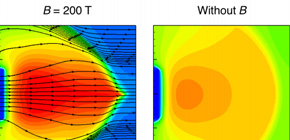
Successful confinement of laser plasma under a strong magnetic field
A step toward the new nuclear fusion energy by combination of laser and magnetic field
A group of researchers from Osaka University, Bordeaux University (France), Kyushu University (Japan), and National Central University (Taiwan), demonstrated that it was possible to make the acceleration of high-energy-density plasma more efficient under a 200-T external magnetic field by using the GEKKO XII laser system at the Institute of Laser Engineering, Osaka University, a world first. The magnetic field of 200 teslas is 200 times greater than a neodymium magnet.
Thermal insulation and confinement of plasma is achieved due to an external magnetic field. There has been an idea of using this for laser nuclear fusion plasma, but it requires a very strong magnetism of several hundred to a thousand teslas, so it has not been experimentally verified.
In 2013, a research group led by Professor Fujioka at the Institute of Laser Engineering at Osaka University published that it was possible to generate kilotesla magnetic fields in a micro space in a short time when a magnetic field generator, called ‘a capacitor-coil target,’ was driven by beams from the GEKKO XII laser, the largest laser system in Japan.
This time, this group generated a 200 T magnetic field by flowing a current driven by high-power laser into the coil. The researchers created high-density plasma, measuring its behavior.
Nuclear fusion is actively being studied all over the world as an ultimate energy source. This group’s research results will lead to the development of new nuclear fusion methods by combining a magnetic field and laser.
Abstract
Recent progress in the generation in the laboratory of a strong ( > 100 -T) magnetic field enables us to investigate experimentally unexplored magnetohydrodynamics phenomena of a high-energy-density plasma, which an external magnetic field of 200–300 T notably affects due to anisotropic thermal conduction, even when the magnetic field pressure is much lower than the plasma pressure. The external magnetic field reduces electron thermal conduction across the external magnetic field lines because the Larmor radius of the thermal electrons in the external magnetic field is much shorter than the mean free path of the thermal electrons. The velocity of a thin polystyrene foil driven by intense laser beams in the strong external magnetic field is faster than that in the absence of the external magnetic field. Growth of sinusoidal corrugation imposed initially on the laser-driven polystyrene surface is enhanced by the external magnetic field because the plasma pressure distribution becomes nonuniform due to the external magnetic-field structure modulated by the perturbed plasma flow ablated from the corrugated surface.
To learn more about this research, please view the full research report entitled " Magnetohyrodynamics of laser-produced high-energy-density-plasma in a strong magnetic field " at this page of the Physical Review E website.
Related link
